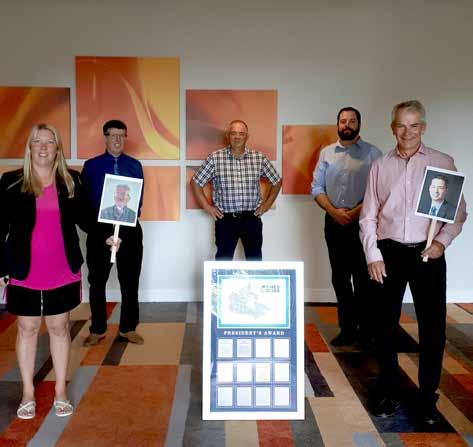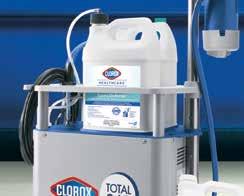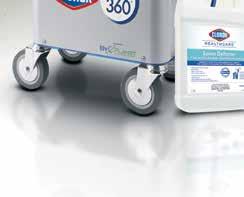
9 minute read
Rising to the Challenge
from CHF Fall 2020
by MediaEdge
RISING TO THE
CHALLENGE Maritime chapter overcomes obstacles to secure second straight award win
It’s hard to believe the outlook for 2020 was so rosy at the start of the year. In what seems like an instant yet forever ago, the world changed and so did everyone’s way of life. Telecommuting has replaced the traditional office for most and virtual meetings are now the norm in response to the coronavirus threat. No industry or organization has been exempt from the impact of COVID19, not even the Canadian Healthcare Engineering Society (CHES).
As the country locked down in midMarch, the association’s regional chapters opted to forego their annual spring conferences in the name of safety, but perhaps the decision was no more difficult than for the Maritime chapter. Host of the 2020 CHES National Conference, the chapter had spent more than a year planning the event in collaboration with the national executive, which amounted to hundreds of volunteer hours that were swiftly discounted by the virus.
“It was disappointing,” says chapter chair, Helen Comeau, frankly.
However, receiving the news that CHES Maritime won the President’s Award for a second straight year has since lifted her spirits, as well as those of the executive team: Robert Barss, Mark McNeill, Gordon Jackson, Ken Morriscey, Andrew Bradley and Kerry Fraser.
“I was extremely honoured as each year it is such a close competition between our chapters,” says Comeau, who accepted the award on behalf of the chapter.
t LEFT TO RIGHT: Helen Comeau with photo of Mark McNeill, Ken Morriscey, Robert Barss, Andrew Bradley and Gordon Jackson with photo of Kerry Fraser. The Maritime chapter has now won the President's Award three times, in 2015, 2019 and 2020.
This is the third time the Maritime chapter has been recognized with the award, the first being in 2015. CHES Ontario is the only other chapter to have achieved such a feat.
The President’s Award is presented annually to the CHES chapter that demonstrates its commitment to education, administration and rep resentation in the activities of the chapter and national board. Each chapter is scored on accounting practices, conference/education day, membership, chapter executive practices, committee work and additional offerings (from submitting articles to Canadian Healthcare Facilities to providing extra member benefits). Specifically, points are given for activities that benefit members and
the work of CHES, such as number of meetings attended in the course of committee work and special education sessions. The recipient of the much-coveted award receives two CHES national conference registrations and expenses to a maximum of $2,500 each, as well as a trophy engraved with the victorious team’s names.
“The continued dedication of our team paid off in what has been an extremely challenging time,” says Comeau.
Despite being unable to meet in person this year (up until Sept. 24 for the award presentation in Moncton, N.B., thanks to the creation of the Atlantic bubble), each member of the chapter executive diligently carried out their duties in addition to their regular healthcare roles, which have become even more demanding amid the pandemic. This on top of the fact that the cancellation of the 2020 CHES National Conference and subsequent rescheduling to next year increased the chapter’s workload, says Comeau.
“We needed new contracts and some of the venues were no longer available so we had to move the conference to October,” she explains. “This change in timing then affected some of our planned events for the companion program.”
On the plus side, the financial impact of the upheaval has been minimal.
“Everyone was so understanding,” says Comeau, who is delighted they were able to secure their preferred venue — the Halifax Convention Centre.
The 2021 CHES National Conference will take place Oct. 17-19, barring any unforeseen setbacks. The theme is still, ‘Enriching Patient Experiences by Optimizing the Environment.’
In lieu of the chapter’s fall education day, which was scheduled for November in Truro, N.S., and also cancelled due to COVID-19, CHES Maritime is considering hosting a virtual learning day sometime next spring.
The chapter is currently exploring ways to increase its membership, too. The executive team is focused on gaining the support of long-term care facilities to achieve this goal.
Despite all the hardships of the past year, Comeau is particularly proud the chapter has been able to balance its books while offering several financial incentives to members, including free webinars, contributions to Canadian Certified Healthcare Facility Manager (CCHFM) exam fees, student bursaries and other rebates.
In August, Patrick LeBlanc was named the recipient of this year’s Per Paasche bursary. The $1,000 grant is presented annually to a family member of a Maritime chapter member to assist with their post-secondary education. Patrick is the son of chapter member Dave LeBlanc, who works with the Nova Scotia Department of Transportation and Infrastructure Renewal. Patrick is pursuing mechanical engineering at the University of Ottawa.
Trust. Mechanical & Electrical Engineering
Emergency Generator Systems designed for your building
1 Concorde Gate,Suite 808 Toronto, Ontario 416.443.9499 mcgregor-a allsop.com


The truth about Healthcare-associated infections.
Healthcare-associated infections (HAIs) are infections that patients get while receiving treatment for medical or surgical conditions. Many HAIs are preventable.1
In the news. Some infectious diseases that start in the community such as severe acute respiratory syndrome (SARS), Middle East Respiratory Syndrome (MERS) and COVID-19, the cause of the current pandemic, may also spread in healthcare facilities.2 Where do they happen?
HAIs occur in all types of care settings, including acute care hospitals, ambulatory surgical centres, dialysis facilities, outpatient care facilities (e.g., physicians’ offices and healthcare clinics), and long-term care facilities (e.g., nursing homes and rehabilitation facilities).1
According to the Canadian Nosocomial Infection Surveillance Program (CNISP), one in 217 patients acquired an infection while in hospital in 2017. While some HAIs were reduced over time, such as Clostridium difficile infections which were reduced by 25% from 2013 to 2017, other HAIs such as vancomycin-resistant enterococci (VRE) infections increased by 25%.3 Device-associated infections, such as ventilator-associated pneumonia, catheter-associated urinary tract infections (CAUTIs), surgical site infections (SSIs) associated with a prosthetic implant and central line–associated bloodstream infection (CLABSIs), accounted for 35.6% of all health care-associated infections in 2017.4
Common types of HAIs.
Common types of HAIs include:2
• Central line-associated bloodstream infections (CLABSI) • Catheter-associated urinary tract infections (CAUTI) • Surgical site infections (SSI) • Clostridium difficile infections • Methicillin-resistant staphylococcus aureus (MRSA) infections • Vancomycin-resistant enterococci (VRE) infections • Carbapenem-resistant Gram-negative bacterial infections
The burden of HAIs.
HAIs constitute a significant burden to society, as they cause significant morbidity and mortality in hospitalized patients. More than 200,000 patients are infected every year while receiving healthcare in Canada and estimates suggest that HAIs are linked to between 8,500 and 12,000 deaths per year, making these infections the fourth leading cause of death for Canadians (behind cancer, heart disease, and stroke).5
Treatment costs for HAIs are high as the cost of containment and control of these outbreaks can really add up.6 Additionally, after discharge, patients with HAIs have significantly higher personal medical costs than uninfected patients. They require more visits from community nurses, greater reliance on hospital outpatient and emergency services, and more visits to their family doctor.2
Prevention is critical.
Environmental cleaning and disinfection is a critical strategy for HAI prevention. According to the Provincial Infectious Disease Advisory Committee (PIDAC), environmental cleaning in the healthcare setting must be performed on a routine and consistent basis to provide for a safe and sanitary environment.7
Cleaning and disinfecting products must be approved by environmental services, infection prevention and control and occupational health and safety.7 Disinfectants must have Health Canada approval and should be compatible with surfaces, finishes, furnishings, items and equipment to be cleaned and disinfected.7 Additionally, they must be used according to the manufacturer’s recommendations and be effective against the microorganisms encountered in the healthcare setting.7
Researchers estimated that about 70% of some types of HAIs could reasonably be prevented if infection prevention and control strategies are followed.8
Make CloroxPro™ part of the process.
CloroxPro™ offers multiple Health Canada–registered disinfectants based on three categories of active disinfectant ingredients – quaternary ammonium compounds (or “quats”), chlorine releasing compounds (such as bleach), and peroxygen compounds (such as hydrogen peroxide), to help meet your healthcare facility’s unique needs.
Learn more, or request a product demo at CloroxPro.ca | healthcare@clorox.com
References: 1. Healthcare-associated infections. Healthy People 2020. https://www.healthypeople.gov/2020/topics-objectives/topic/healthcare-associated-infections Accessed March 10, 2020. 2. Evaluation of healthcareassociated infection activities at the Public Health Agency of Canada 2012-13 to 2016-17. March 2018. https://www.canada.ca/content/dam/phac-aspc/documents/corporate/transparency/corporate-management-reporting/ evaluation/HAI_evaluation-eng.pdf Accessed March 12, 2020. 3. Healthcare-associated infection rates in Canadian hospitals. Public Health Agency of Canada. Canadian Nosocomial Infection Surveillance Program (CNISP). https://www.canada.ca/content/dam/canada/public-health/services/publications/science-research-data/healthcare-associated-infection-rates-canadian-hospitals-infographic/CNISP-2013-2017-infographic-eng.pdf Accessed March 13, 2020. 4. Mitchell R, et al. Trends in healthcare-associated infections in acute care hospitals in Canada: An analysis of repeated point-prevalence surveys. CMAJ 2019;191(36):E981-8. 5. Health care associated infections: A backgrounder. Canadian Union of Public Employees, 2009. https://cupe.ca/sites/cupe/files/healthcare-associated-infections-cupe-backgrounder.pdf Accessed March 9, 2020. 6. Dik J-W H, et al. Cost-analysis of seven nosocomial outbreaks in an academic hospital. PLoS ONE 2016;11(2):e0149226. 7. Ontario Agency for Health Protection and Promotion (Public Health Ontario), Provincial Infectious Diseases Advisory Committee. Best practices for environmental cleaning for prevention and control of infections in all health care settings. 3rd ed. Toronto, ON: Queen’s Printer for Ontario; 2018. 8. The Chief Public Health Officer’s Report on the state of public health in Canada 2013: Infectious Disease – The Never-ending Threat. https://www.canada.ca/content/dam/phac-aspc/migration/phac-aspc/cphorsphc-respcacsp/2013/assets/pdf/2013-eng.pdf Accessed March 16, 2020.
The invisible guardian.



Everyday sporicidal protection now available for the Clorox Total 360® system. for the Clorox Total 360® system.





In addition to our current line of disinfection formulations and products, CloroxPro™ offers a new Spore Defense™ formulation, exclusively for the Clorox Total 360® system. This powerful new chemistry is Health Canada-approved to kill: ♦ C. difficile in 5 minutes ♦ 42 out of 47 pathogens in just 1 minute, including MRSA, VRE, measles & polio







Clorox Total 360® system with Spore Defense™, when used regularly, provides Clorox Total 360® system with Spore Defense™, when used regularly, provides your facility with invisible yet effective outbreak prevention.








